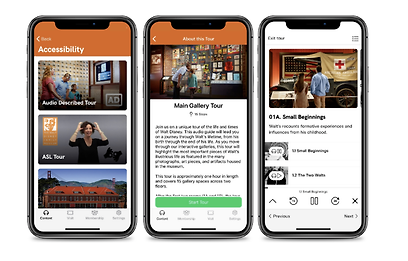76% of all US leisure travelers visit museums or cultural heritage sites during their trips. These visits contribute $50 billion to the US economy each and every year.
During and after the worst of the Covid-19 pandemic, museums spent a higher-than-normal amount on technology in order to adapt to the public’s need for virtual experiences and to re-open safely.
Some museums are still working on creating visitor experiences that meet modern expectations. Meanwhile, others are looking to invest in digital experiences that go beyond safety in order to provide more meaningful content and achieve their goals for community impact.
No matter where you’re at—whether that’s implementing cloud-based tech for the first time or bending AR to your will—we’ve got insights into the top museum tech for 2023.
Take a look at the trends that will power museums next year and how you can make them your own.
1. Tech-powered accessibility
Digital information is a major component of ADA compliance. Museums can employ technology to make both digital and in-person experiences more accessible to those with disabilities. For example, you can use multimedia content to satisfy the needs of more people. Audio content can assist the hearing impaired, while videos, images, and transcripts can help those with hearing impairments.
It’s also important to provide content in the languages that matter to your visitors. You can use digital museum displays and tour apps to provide multilanguage content that won’t clutter your physical displays. Some museums are utilizing AI translation text to speed up the bulk of the translation work. (If you do use AI, make sure to hire a translator or copyeditor to fix any errors.)
2. Immersive AR experiences
AR is one of the biggest technology trends for museums, because it offers the ability to create almost-realistic experiences that immerse visitors in the time period, art style, or content of your exhibit.
For example, The National Museum of Natural History in Paris, France created an augmented reality experience to bring extinct species back to life.
We can expect to see lots more exhibits utilizing AR in the coming years, especially ones targeting children and families.
3. Self-guided audio tours
The Walt Disney Family Museum uses their audio tour guide app to tell the story of Walt Disney’s life and work.

Walt Disney Family Museum app
The use of audio tours like Walt Disney Family Museum’s have skyrocketed in the past couple of years, as more museums sought to:
- Do away with the hassle of audio device rentals
- Satisfy visitors who wanted to avoid group tours
- Allow visitors to use their own devices (for a more hygienic experience)
We can expect more museums to adopt this technology, as it becomes standard-practice to provide a digital tour alongside docents and group tours (as an option for when visitors would rather go it alone).
Museums that have already adopted this technology will seek to make better use of it in 2023. They might tell additional stories and measure their impact on the community, social stigmas, and issue awareness.
4. Interactive digital displays to replace physical ones
Replacing physical displays with digital ones is an ongoing project. We can expect to see more museums using kiosk software and continuing to build out their digital experiences.
When replacing physical displays, it’s not just a matter of making the content digital. You should take this opportunity to reimagine the entire content experience, now that you have limitless potential. For example, you might make interactive maps, scenes, or timelines.
5. Cloud-based ticketing
A cloud-based ticketing system is one essential piece of museum software. It can bring your museum up to speed with modern expectations by providing paperless tickets, contactless entry, and timed entry slots.
While most large museums already have such a solution in place, we can expect smaller organizations to adopt this technology as well.
6. QR codes galore
QR codes are a simple but powerful piece of technology for museums. Visitors can scan the code to pull up any URL in their mobile web browser.
You might use QR codes in your cafe or restaurant to share the menu in a germ-free way. Or, you can add QR codes to your informational kiosks or signage to share the link to your museum app. You might also encourage visitors to sign up for your email newsletter, purchase a membership online, or make a donation.
7. Discoverable collections websites
Gone are the days of hidden, private collections. Today, more museums are jumping on the trend of making their collections more widely available. This way, they can attract additional visitors and patrons.
You can use a digital collections platform to create a beautiful website with images, videos, audio file, and text. Make sure to SEO optimize every item in your collection so that it can be easily found online.
With this technology, you can integrate your backend CMS with your public digital collections so that you don’t have to maintain separate systems or lose out on online traffic sources.
8. Hybrid virtual programming
Thousands of museums across the US rapidly deployed virtual experiences and programs during the pandemic. While people are craving in-person experiences now, there are still use cases for virtual programs. Overseas participants, students, and elderly or disabled people can all enjoy your programming virtually.
We expect to see more museums take a hybrid approach, where they’ll offer a virtual component of an in-person experience. For example, Senior Planet offers seniors the ability to come in-person to museum tours in New York or to tour them virtually.
Technology should never be pursued for its own sake. Instead, it should positively impact your visitor experience or your internal productivity. So consider recent complaints or suggestions from visitors and staff to help you decide which technology is right for your museum.